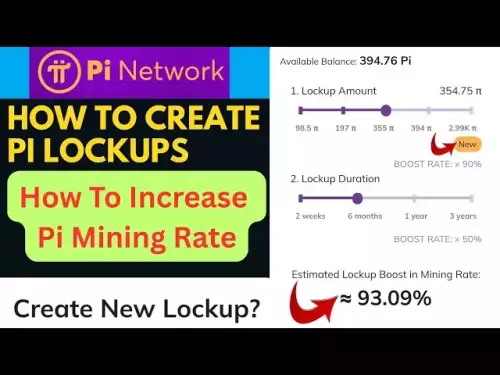 |
|
 |
|
 |
|
 |
|
 |
|
 |
|
 |
|
 |
|
 |
|
 |
|
 |
|
 |
|
 |
|
 |
|
 |
|
Cryptocurrency News Articles
When Will Tokens Generate Revenue? By Joel John, Decentralised.co
Mar 14, 2025 at 07:04 am
This article asks a simple question, should tokens generate revenue? If so, should teams buy back their own tokens?

Money controls everything around us. When people start discussing fundamentals again, the market is probably in a bad place.
This article asks a simple question: should tokens generate revenue? If so, should teams buy back their own tokens? Like most things, there is no clear answer to this question. The path forward needs to be paved with honest conversations.
This article was inspired by a series of conversations with Ganesh Swami, co-founder of Covalent, a blockchain data query and indexing platform. It covers the seasonality of protocol revenue, evolving business models, and whether token buybacks are the best use of protocol capital. It also complements the article I wrote last Tuesday about the current state of stagnation in the cryptocurrency industry.
Private equity capital markets such as venture capital always swing between periods of excess liquidity and periods of liquidity scarcity. When these assets become liquid assets and external funds continue to pour in, the industry's optimism tends to drive prices up. Think of various new IPOs or token issuances. This newly acquired liquidity will allow investors to take more risks, in turn driving the birth of a new generation of companies. When asset prices rise, investors will shift their attention to early-stage applications, hoping to obtain higher returns than benchmarks such as Ethereum and SOL.
This phenomenon is a characteristic of the market, not a problem.
Liquidity in the cryptocurrency industry follows a cyclical cycle marked by the halving of Bitcoin block rewards. From historical data, market rebounds usually occur within six months after the halving. In 2024, the inflow of funds from Bitcoin spot ETFs and Michael Saylor's large-scale purchases (a total of $22.1 billion was spent on Bitcoin last year) became a "reservoir" for Bitcoin. However, the rise in Bitcoin prices did not lead to an overall rebound in small altcoins.
We are currently in a period of tight capital liquidity, capital allocators' attention is scattered across thousands of assets, and founders who have been working on developing tokens for years are struggling to find the meaning of it all. "Why bother building real applications when launching meme assets can bring more economic benefits?"
In previous cycles, L2 tokens have enjoyed a premium due to the perceived underlying value, supported by exchange listings and venture capital. However, as more and more players enter the market, this perception and its valuation premium are being eroded. As a result, L2's token value has declined, limiting their ability to subsidize smaller products with grants or token revenue. Moreover, the valuation surplus has in turn forced founders to ask the old question that plagues all economic activities: where does the revenue come from?
How Cryptocurrency Project Revenue Works
The above diagram explains very well how cryptocurrency project revenue typically works. For most products, Aave and Uniswap are undoubtedly ideal templates. These two projects have maintained stable fee income for many years by virtue of their early entry into the market and the "Lindy Effect". Uniswap can even generate revenue by increasing front-end fees, which perfectly confirms consumer preferences. Uniswap is to decentralized exchanges what Google is to search engines.
In contrast, the revenues of Friend.tech and OpenSea are seasonal. For example, the "Summer of NFTs" lasted for two quarters, while the speculative craze in Social-Fi lasted only two months. Speculative income is understandable for some products, provided that the scale of its revenue is large enough and consistent with the original intention of the product. Currently, many meme trading platforms have joined the club of over $100 million in fee income. This scale of revenue is usually only achievable for most founders through token sales or acquisitions. This level of success is not common for most founders who focus on developing infrastructure rather than consumer applications, and the revenue dynamics of infrastructure are different.
Between 2018 and 2021, venture capital firms provided a lot of funding for developer tools, expecting developers to gain a large number of users. But by 2024, two major shifts have occurred in the cryptocurrency ecosystem:
First, smart contracts enable unlimited scalability with limited human intervention. Today, Uniswap and OpenSea no longer need to scale their teams in proportion to trading volume.
Secondly, advances in large language models (LLMs) and artificial intelligence have reduced the need to invest in cryptocurrency developer tools. Therefore, as an asset class, it is at a "reckoning moment".
In Web2, API-based subscription models work because there are so many users online. However, Web3 is a smaller niche market with very few applications that can scale to millions of users. Our advantage is the high revenue per customer. Due to the nature of blockchain that allows money to flow, ordinary users in the cryptocurrency industry tend to spend more money at a higher frequency. Therefore, in the next 18 months, most companies will have to redesign their business models to obtain revenue directly from users in the form of transaction fees.
Of course, this isn’t a new
Disclaimer:info@kdj.com
The information provided is not trading advice. kdj.com does not assume any responsibility for any investments made based on the information provided in this article. Cryptocurrencies are highly volatile and it is highly recommended that you invest with caution after thorough research!
If you believe that the content used on this website infringes your copyright, please contact us immediately (info@kdj.com) and we will delete it promptly.






























































